
Photographica Pages
An online guide to collectable cameras and related stuff
Leica A
The Leica A series cameras can be broken down into subgroups. All except the Luxus are finished in
black enamel and leather. All have fixed lenses, all excepting the Hektor are 50/3.5.
Leica Null Series
The first group chronologically would be the Null series. This is the very first group of Leicas built, split
into two batches. According to records which are a bit sketchy, the first batch consisted of seven
cameras, the second consisted of fifteen. Reportedly there was to be 31 cameras built, but a change
was made that actually makes the last nine cameras allocated to this model actually examples of the
second model, the Anastigmat.
As these were pre-production cameras, these cameras have many small, and not so small differences.
The biggest difference is in the finder, first a folding finder, later replaced by a tubular finder with
crosshairs, and then finally without.
On all of these examples the shutter is not self capping, the lens cap had to be placed on the lens when
winding the film. The shutter speeds were marked by shutter slit width, rather than times.
The first batch of cameras were numbered 100-106, the second continuing with 107 continuing
through 122 . Things are confusing, and it appears that numbers 123 through 125 were not used, and
beyond that they became Anastigmats.
Even though the next batch of cameras are refered to as Anastigmats, the null series are equipped with
the same lens.
Leica Anastigmats
From here on out the cameras are grouped by the lenses mounted.
The Anastigmat was the first production Leica camera. Introduced at the Leipzig Spring Fair in 1925,
production started where the previous model left off, at serial number 126, and continued up until about
number 300. These cameras feature a self capping shutter, and are basically the same throughout
the production of the Leica A series, with a few minor differences, such as variations in the shutter
release button, rewind knob, accessory shoe and baseplate locking key.
Leica Elmax
The Anastigmat design was changed to the Elmax at about serial number 300, and was continued until
about number 1300, for a production of about 1000 cameras.
Leica Elmar
The lens design was simplified by eliminating an element, creating a four element design. This lens
was very popular, and was available in different versions, and was recently re-released in the 2.8
version for the M6! Cameras can be found with this lens through the end of A production, in the 71,000
serial number range.
Variations in the lens include markings in feet, for the US market, and meters for Europe, and there is
slight variation in optical formula, and most likely the types of glass.
This is by far the most common Leica A.
Leica Hektor
In 1930 Leitz offered a choice of lenses fitted fitted to the Leica. The new lens was of faster speed, the
50/2.5 Hektor. Introduced at about camera number 38,000, it was available until the end of
production.
Leica Luxus
One of the most coveted cameras ever produced is the Leica Luxus. It is a Leica A, almost always with
an Elmar, finished in gold with colored lizard skin. A matching lizard skin case, and gold rangefinder
were also available. Only about 95 were produced, three supposedly with Hektor lenses. The cameras
was a marketing failure, as it was considered to gaudy.
With many rare cameras that are variations of a more common camera, care must be exercised about
fakes. This is likely the single most counterfeited camera of all time, with fakes running the gamut from
obvious to indistinguishable from the real thing.
At least two gold Leica stereo attachments are known. Also, the Luxus has been documented based on
the Model C.
Other Characteristics
Early cameras have a smooth shutter release button commonly referred to as the
"mushroom release". The cable release did not thread in, and had to
clip across the camera, which was awkward and cumbersome. This style release button
was replaced with one having a "dimple" in it, which allowed the cable
release to work a little better as it would have less of a tendency to slip off
of the dome. The final version is the most common, which is the standard
threaded type.
There were some other small changes made during the course of production. The
locking key on the baseplate went from being black with a nickel ring to all
nickel and a slightly different shape. The wind knob is a bit shorter, and the
grain of the vulcanite changes. Also, the style of engraving on the lens is a
little thicker on the earlier Elmar lenses.
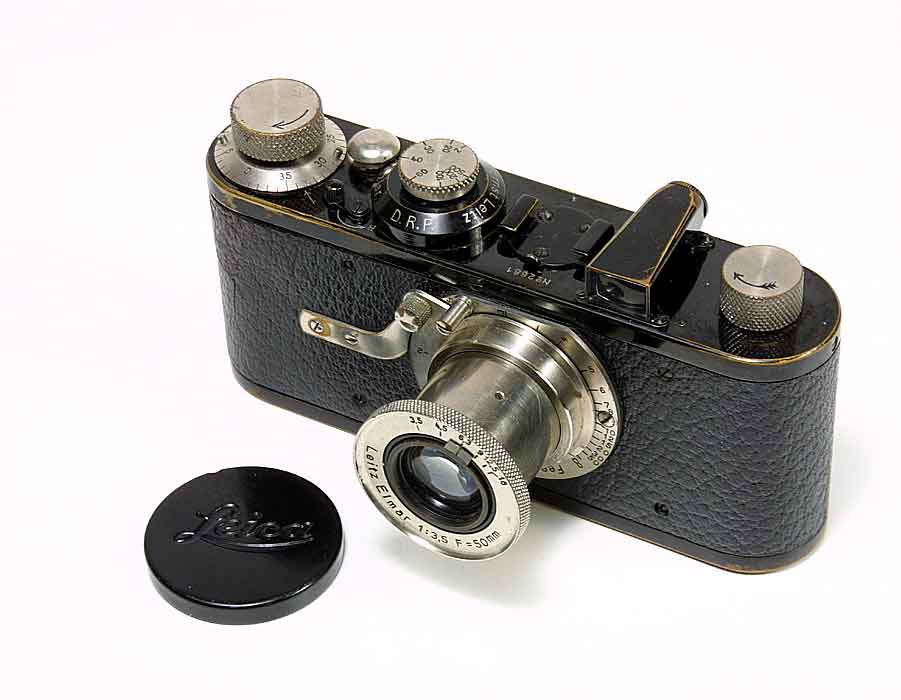
An early example of the Leica A.
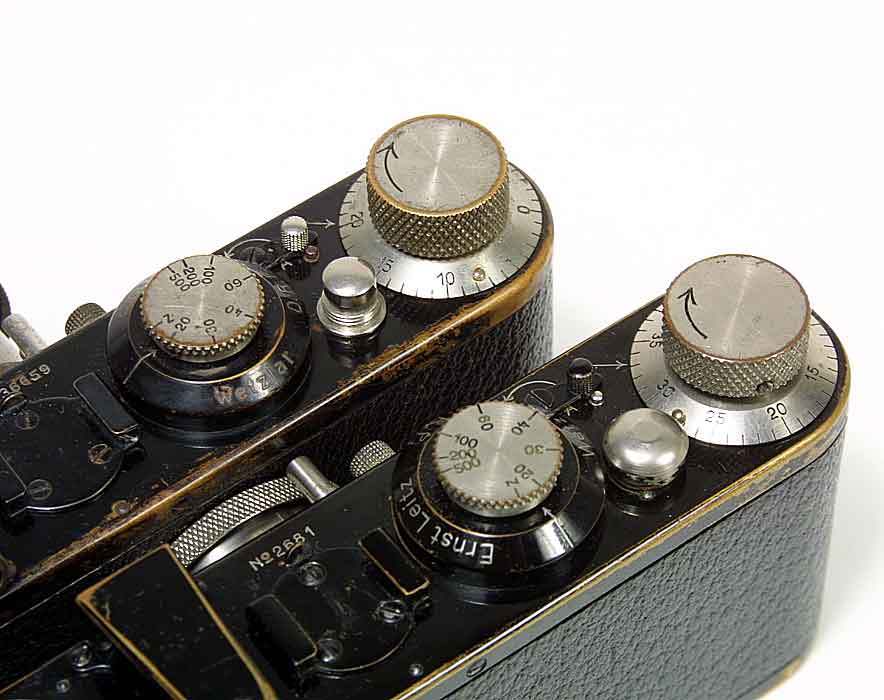
The "dimple" release (closest), and the later style release compared.
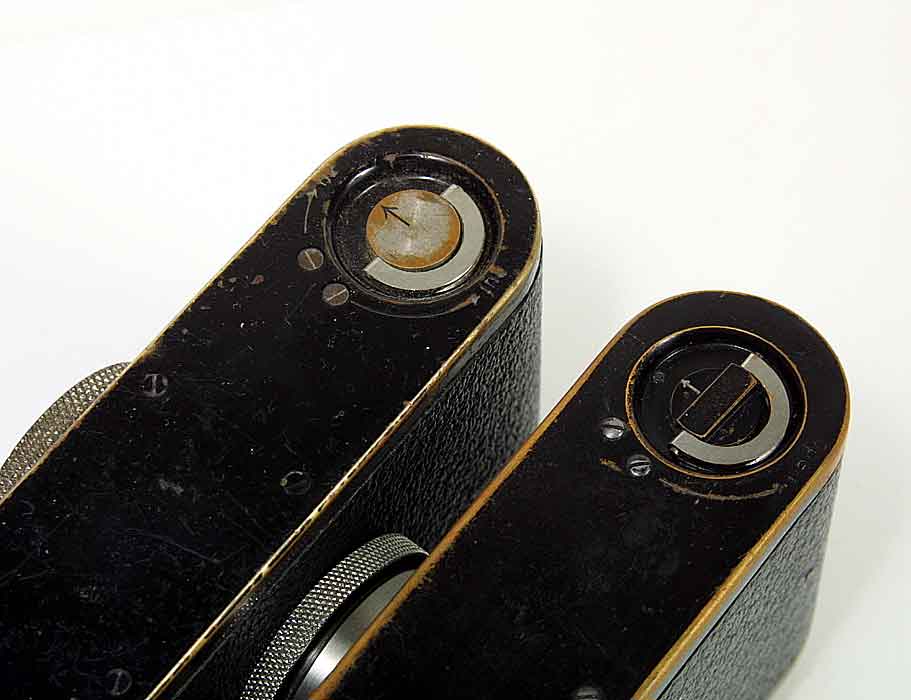
Early style baseplate lock (closest) and later style.

A comparison of the differences in engraving on the lenses, the early style on the
left.
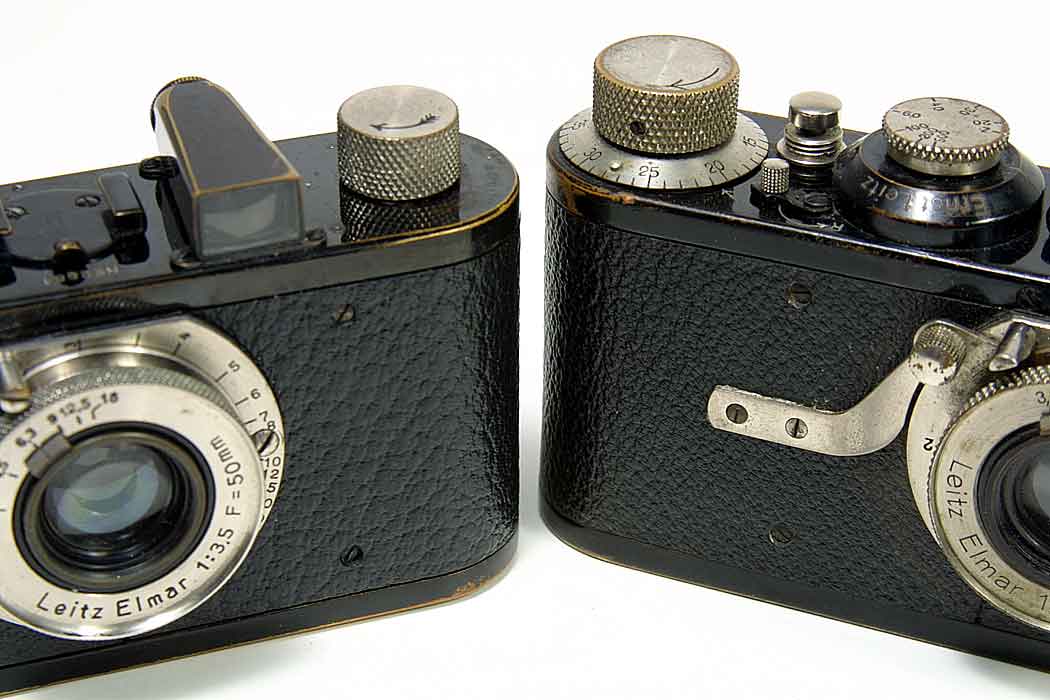
A comparison of the different grain in the vulcanite, the early style on the left.
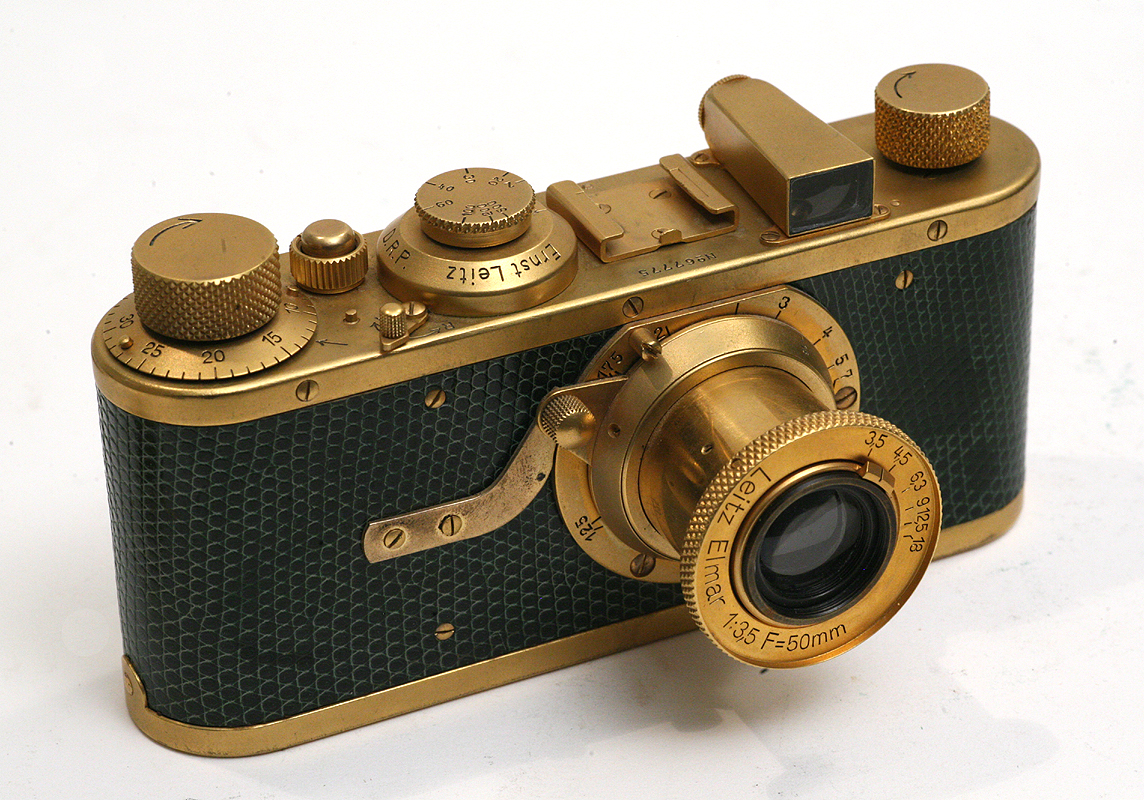
The Leica Luxus.
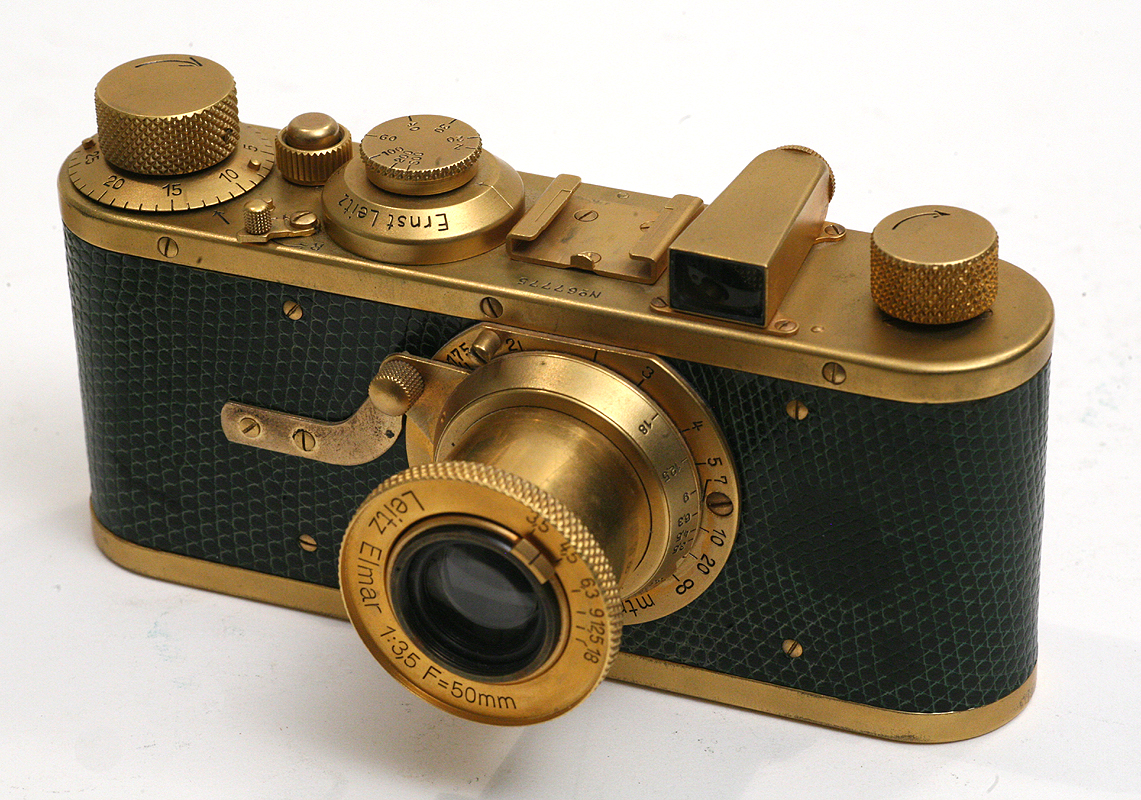
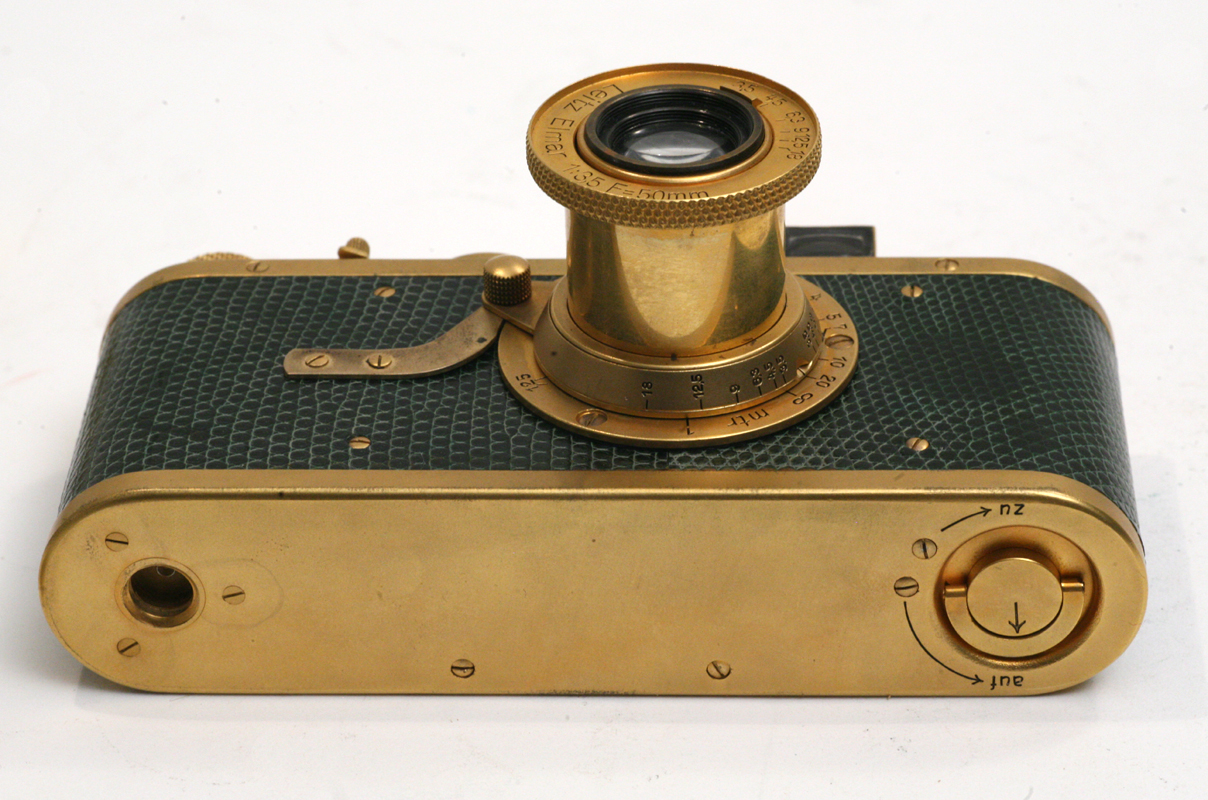
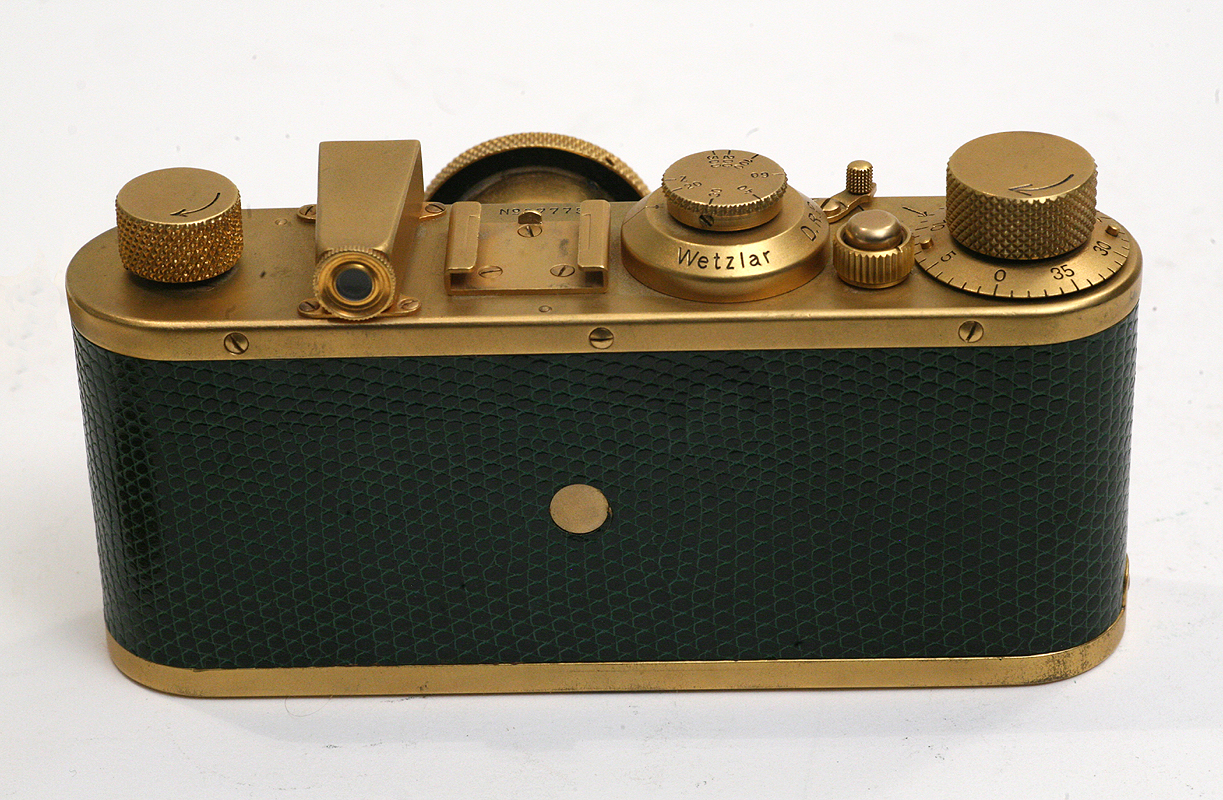
Leica A production by lens and year:
Year
Anastigmat Elmax Elmar Hektor<
/B>
1925
144 713 -0- -0-
1926
-0- -0- 1524 -0-
1927
-0- -0- 2940 -0-
1928
-0- -0- 7069 -0-
1929
-0- -0- 16,367 -0-
1930
-0- -0- 16,339 740
1931
-0- -0- 11,471 589
1932
-0- -0- 789 1
1933
-0- -0- 6 -0-
1934
-0- -0- 15 -0-
1935
-0- -0- 18 -0-
1936
-0- -0- 1 -0-
Total
144 713 56,548 1330
The Leica A series cameras can be broken down into subgroups. All except the Luxus are finished in black enamel and leather. All have fixed lenses, all excepting the Hektor are 50/3.5.
Leica Null Series
The first group chronologically would be the Null series. This is the very first group of Leicas built, split into two batches. According to records which are a bit sketchy, the first batch consisted of seven cameras, the second consisted of fifteen. Reportedly there was to be 31 cameras built, but a change was made that actually makes the last nine cameras allocated to this model actually examples of the second model, the Anastigmat.As these were pre-production cameras, these cameras have many small, and not so small differences. The biggest difference is in the finder, first a folding finder, later replaced by a tubular finder with crosshairs, and then finally without.
On all of these examples the shutter is not self capping, the lens cap had to be placed on the lens when winding the film. The shutter speeds were marked by shutter slit width, rather than times.
The first batch of cameras were numbered 100-106, the second continuing with 107 continuing through 122 . Things are confusing, and it appears that numbers 123 through 125 were not used, and beyond that they became Anastigmats.
Even though the next batch of cameras are refered to as Anastigmats, the null series are equipped with the same lens.
Leica Anastigmats
From here on out the cameras are grouped by the lenses mounted.
The Anastigmat was the first production Leica camera. Introduced at the Leipzig Spring Fair in 1925, production started where the previous model left off, at serial number 126, and continued up until about number 300. These cameras feature a self capping shutter, and are basically the same throughout the production of the Leica A series, with a few minor differences, such as variations in the shutter release button, rewind knob, accessory shoe and baseplate locking key.
Leica Elmax
The Anastigmat design was changed to the Elmax at about serial number 300, and was continued until about number 1300, for a production of about 1000 cameras.
Leica Elmar
The lens design was simplified by eliminating an element, creating a four element design. This lens was very popular, and was available in different versions, and was recently re-released in the 2.8 version for the M6! Cameras can be found with this lens through the end of A production, in the 71,000 serial number range.
Variations in the lens include markings in feet, for the US market, and meters for Europe, and there is slight variation in optical formula, and most likely the types of glass.
This is by far the most common Leica A.
Leica Hektor
In 1930 Leitz offered a choice of lenses fitted fitted to the Leica. The new lens was of faster speed, the 50/2.5 Hektor. Introduced at about camera number 38,000, it was available until the end of production.
Leica Luxus
One of the most coveted cameras ever produced is the Leica Luxus. It is a Leica A, almost always with an Elmar, finished in gold with colored lizard skin. A matching lizard skin case, and gold rangefinder were also available. Only about 95 were produced, three supposedly with Hektor lenses. The cameras was a marketing failure, as it was considered to gaudy.
With many rare cameras that are variations of a more common camera, care must be exercised about fakes. This is likely the single most counterfeited camera of all time, with fakes running the gamut from obvious to indistinguishable from the real thing.
At least two gold Leica stereo attachments are known. Also, the Luxus has been documented based on the Model C.
Other Characteristics
Early cameras have a smooth shutter release button commonly referred to as the "mushroom release". The cable release did not thread in, and had to clip across the camera, which was awkward and cumbersome. This style release button was replaced with one having a "dimple" in it, which allowed the cable release to work a little better as it would have less of a tendency to slip off of the dome. The final version is the most common, which is the standard threaded type.
There were some other small changes made during the course of production. The locking key on the baseplate went from being black with a nickel ring to all nickel and a slightly different shape. The wind knob is a bit shorter, and the grain of the vulcanite changes. Also, the style of engraving on the lens is a little thicker on the earlier Elmar lenses.

An early example of the Leica A.

The "dimple" release (closest), and the later style release compared.

Early style baseplate lock (closest) and later style.

A comparison of the differences in engraving on the lenses, the early style on the left.

A comparison of the different grain in the vulcanite, the early style on the left.

The Leica Luxus.



Leica A production by lens and year:
Year | Anastigmat | Elmax | Elmar | Hektor< /B> |
1925 | 144 | 713 | -0- | -0- |
1926 | -0- | -0- | 1524 | -0- |
1927 | -0- | -0- | 2940 | -0- |
1928 | -0- | -0- | 7069 | -0- |
1929 | -0- | -0- | 16,367 | -0- |
1930 | -0- | -0- | 16,339 | 740 |
1931 | -0- | -0- | 11,471 | 589 |
1932 | -0- | -0- | 789 | 1 |
1933 | -0- | -0- | 6 | -0- |
1934 | -0- | -0- | 15 | -0- |
1935 | -0- | -0- | 18 | -0- |
1936 | -0- | -0- | 1 | -0- |
Total | 144 | 713 | 56,548 | 1330 |
